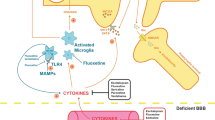Abstract
Reserpine caused a decrease in the state 3, respiratory control ratio (RCR) and ADP/O ratio in frontal cortex, striatum and liver of rats 1 h after drug administration. State 4 respiratory rate was stimulated in frontal cortex and striatum. In the liver, 6-OHDA decreased the ADP/O ratio when both pyruvate/malate and succinate were used as substrates. Reserpine induced changes in the activities of Na+K+-ATPase and Mg2+-ATPase in frontal cortex and liver 15 min and 4 h after administration of the drug. In the liver only 6-OHDA caused the depression of Mg2+-ATPase activity (P<0.05). Reserpine altered the levels of K+, Na+ and Ca2+ cations in rat frontal cortex and striatum, while 6-OHDA caused a decrease in the amount of Mg2+ in liver (P<0.05).
Similar content being viewed by others
References
Hatefi Y (1985) The mitochondrial electron transport and oxidative phosphorylation system. Annu Rev Biochem 54:1015–1069
Barbee SJ, Hartung R (1979) Diethanolamine-induced alteration of hepatic mitochondrial function and structure. Toxicol Appl Pharmacol 47:431–440
Osubor CC, Nwanze EAC (1993) Acute changes in oxygen consumption and oxidative phosphorylation by 1-methyl-4-phenyl-1,2,3,6-tetrahydropyridine (MPTP) in mouse brain following in vivo administration. Med Sci Res 21:99–100
Alto L, Dhalla NS (1979) Effects of some antiarrhythmic agents on dog heart mitochondrial oxidative phosphorylation. Eur J Pharmacol 59:311–314
Heinz E (1967) Transport through biological membranes. Annu Rev Physiol 29:21–58
Rossier BC, Geering K, Kraehenbuhl JP (1987) Regulation of the sodium pump: how and why? Trends Biochem Sci 12:483–487
Gomperts BD (1986) Calcium shares the limelight in stimulus—secretion coupling. Trends Biochem Sci 11:290–292
Israel Y, Salazar I (1967) Inhibition of brain microsomal adenosine triphosphateses by general depressants. Arch Biochem Biophys 122:310–317
Kass GEN, Wright JM, Nicotera P, Orrenius S (1988) The mechanism of 1-methyl-4-phenyl-1,2,3,6-tetrahydropyridine toxicity: role of intracellular calcium. Arch Biochem Biophys 260:789–797
Stitzel RE (1976) The biological fate of reserpine. Pharmacol Rev 28:179–205
Axelrod J, Tomchick R (1959) Activation and inhibition of adrenaline metabolism. Nature 184:2027–2032
Carlsson A, Hillarp NA, Waldeck B (1962) Mg2+-ATP dependent storage mechanism in the amine granules of the adrenal medulla. Med Exp 6:47–53
Porter CC, Totaro JA, Burcin A (1965) The relationship between radioactivity and norepinephrine concentrations in the brains and heart of mice following administration of labelled methyldopa or 6-hydroxydopamine. J Pharmacol Exp Ther 150:17–22
Laverty R, Phelan EL (1969) Effects of 6-hydroxydopamine on noradrenaline storage and uptake in the rat. Proc Univ Otago Med School 47:18–19
Tranzer JP, Thoenen H (1967) Electron microscopic localization of 5-hydroxydopamine (3,4,5-trihydroxyphenylethylamine), a, new false sympathetic transmitter. Experientia, 23: 743–745
Heikkila RE, Cohen G (1972) In vitro generation of hydrogen peroxide from 6-hydroxydopamine. Experientia 28:1197–1198
Heikkila RE, Cohen G (1973) 6-hydroxydopamine: evidence for superoxide radical as an oxidative intermediate. Science 181:456–457
Maina G (1974) Reserpine as an uncoupling agent. Biochim Biophys Acta 333:481–486
Wagner K (1971) Uncoupling of oxidative phosphorylation by 6-hydroxydopamine. In: Malmfors T, Thoenen H (eds) 6-hydroxydopamine and catecholamine neurones. North-Holland, Amsterdam, pp 277–278
Thakar JH, Hassan MN (1988) Effects of 6-hydroxydopamine on oxidative phosphorylation of mitochondria from rat striatum, frontal cortex and liver. Can J Physiol Pharmacol 66:376–379
Jonsson G, Nwanze E (1982) Selective (+)—amphetamine neurotoxicity on striatal dopamine nerve terminals in the mouse. Br J Pharmacol 77:335–345
Bonting SL (1970) Sodium-potassium activated adenosine triphosphatase and cation transport. In: Bittar EE (ed) Membranes and ion transport vol 1. Wiley-Interscience, New York, pp 257–363
Fiske CH, Subbarrow Y (1925) The colorimetric determination of phosphorus. J Biol Chem 60:375–400
Takeo S, Fliegel L, Beamish RE, Dhalla NS (1980) Effects of adrenochrome on rat heart sarcolemma ATPase activities. Biochem Pharmacol 29:559–564
Lowry OH, Rosebrough NJ, Farr AL, Randall RT (1951) Protein measurement with folin phenol reagent. J Biol Chem 193:265–275
Thakar JH, Hassan MN (1988) Effects of 1-methyl-4-phenyl-1,2,3,6-tetrahydrophyridine (MPTP), cyperquat (MPP+) and paraquat on isolated mitochondria from rat striatum, cortex and liver. Life Sci 43:143–149
Coyle JT, Axelrod J (1971) Development of the uptake and storage ofl-[3H]—norepinephrine in the rat brain. J Neurochem 18:2061–2075
Heikkila RE, Cohen G (1971) Inhibition of biogenic amine—uptake by hydrogen peroxide. A mechanism for toxic effects of 6-hydroxydopamine. Science 173:1257–1258
Giachetti A, Shore, PA (1970) Permeability changes induced in the adrenergic neurone by reserpine. Biochem Pharmacol 19:1621–1626
Shore PA, (1972) Transport and storage of biogenic amines. Annu Rev Pharmacol 12: 209–226
Shankar R, Mishra OP (1974) Effect of reserpine on cation contents of rat brain. Nature 251:532
Author information
Authors and Affiliations
Rights and permissions
About this article
Cite this article
Osubor, C.C., Nwanze, E.A.C. Inhibition of rat mitochondrial functions in vivo by 6-OHDA and reserpine. Res. Exp. Med. 194, 109–117 (1994). https://doi.org/10.1007/BF02576371
Received:
Accepted:
Issue Date:
DOI: https://doi.org/10.1007/BF02576371




